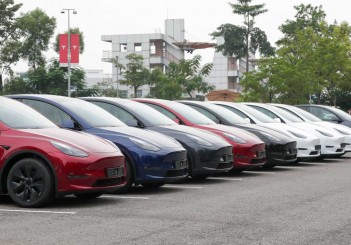
It looks good, doesn’t it? Having the speedometer marked in high triple digits than your stock car will never achieve. It’s all a marketing ploy; seeing big numbers on the meter, to a car buyer, is psychologically “satisfying”, for want of a better word. It also implies that the car has a strong engine. In reality, most cars today can’t hit those speeds (it’s illegal anyway). In many instances, car makers will not even print the top speed in their brochures unless the car in question is a sports car.
2. Why some cars have flat-bottomed steering wheel.
This type of steering wheel is often found in performance cars, which copied the styling from racing cars.
Racing cars, because of their cramped cockpits and sometime requiring the need for driver changes, had their steering wheel moulded with a flat-bottom for easy driver entry and exit.
A few seconds faster does help in motorsports where winners and second-placers can be

3. Why there is an arrow on the fuel gauge.
It can be an arrow or a fuel pump symbol and its location is telling. They serve the same purpose - to gently remind the driver where the fuel tank inlet is. Left or right? We sometimes forget as we roll into the petrol station.

4. Why French cars have a keyhole on the left door instead of the driver’s door.
France is a left-hand drive country and its car makers designed their vehicles to meet the left-hand drive requirements. So when French car makers convert to suit the right-hand drive markets ie Malaysia, Japan, Britain etc, the keyhole on the left side of the car was left unchanged, probably in a move to save costs on retooling. Also, as all new cars are now equipped with remote unlocking/locking features or Keyless entry and go, does anyone actually use the keyhole to unlock or lock their car doors anymore?
5. Why people think CBU (fully imported) cars are of better quality than CKD (locally assembled) cars.
This line of thinking comes about as many people feel that workers in countries that designed and produced cars are better trained and more knowledgeable than those in countries which just assemble cars from parts shipped in from elsewhere.
This also stems from the misconception that higher standard of living, along with higher wages and benefits paid to overseas workers have played a role in ensuring higher quality automobiles.
6. Why right-hand-drive cars are the minority in the world.
Actually, only some 10% of cars are right-hand drive. This is because the big car markets such as the United States, China, Europe, the entire Latin America and Middle East, and a large portion Africa are using the left-hand drive and they tank up a chunk of the annual global car demand.
In essence, almost new cars are designed in the left-hand drive and converted into right-hand drive if there is sufficient demand. The majority of American car models were never converted into the right-hand drive as the market was considered too puny for the “Big Three.”
7. Why carbon fibre parts are so expensive in cars.

Carbon fibre strands.
Carbon fibre parts, unlike most metal parts which are machine stamped in seconds, are painstakingly produced using manual labour and takes a much longer time. They are hand-laid on moulds and then have to be baked for hours before they can be completed. Also, carbon fibre in raw form is also not cheap compared with metal.
Having said that, carbon fibre reinforced parts are highly desirable as their main advantages are their high strength and light weight that make them suitable for use in exotic sports cars, which require those properties for speed and crash safety. BMW is, so far, the only car maker in the world that is using carbon fibre in serial production of its i3/i8 cars, the 7 Series and likely in the chassis of its motorcycles in future.
8. Why electric power steering saves more fuel, compared with conventional hydraulic steering.
According to Robert Bosch Automotive Steering, the electric steering is superior as it is practically maintenance-free, and power is only required when the vehicle is actually being steered. This means less fuel consumption, or energy savings of up to 90% compared with hydraulic power systems.
It works by using an electronically controlled electric motor which replaces the conventional hydraulic system. Control and steering assistance are powered by a single, uncomplicated source: current. There are many examples of this in cars today, such as Ford’s EPAS (electric power-assisted steering) which only uses energy when the steering wheel is turned.
So it uses less energy, further improving fuel economy.










